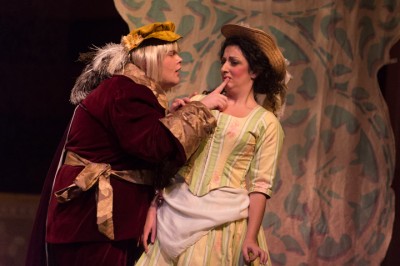Cast members from Gilbert & Sullivan’s Patience discuss the timeless themes within this hilarious production
Gilbert and Sullivan wrote Patience as a satire, poking fun at the aesthetic movement of the 1860's and 70's through a topsy-turvy love story. When CSU opera director Dr. Tiffany Blake originally chose the show, she contemplated setting it in an updated time period due to the characters and stereotypes that can apply to modern day. But she feared the essence of the aesthetic movement from Gilbert and Sullivan’s age wouldn’t be captured in the modern setting.
Many people have compared the aesthetics from Oscar Wilde’s time to the bohemian hippies of the 1960’s, but when talking to a few members from the cast of CSU’s production of Patience, they compared the aesthetics to a more recent trend, the quirky grunge artists known as “hipsters.” A particularly well-known cultural trend to the college-aged group, it was an easy connection for the cast to make, but how similar are these two cultural trends?
Westin Sorrel, who plays the role of Grosvenor describes aesthetics as being “proper – knowing what is beautiful and artistic.” An aesthetic was known for believing that art was created to give pleasure – art for art’s sake. Their motto was “to exist beautifully.” This was considered to be a type of cult trend from 1860 to 1900, and the movement contrasted the mainstream corseted, drab, dark trends that were popular in fashion, architecture, and literature during the Victorian era.
The aesthetics were different. They painted their rooms with bright hues, wore loosely draped dresses rather than corsets, and wrote dramatic poems because they believed that appreciating beauty made one a better person. James McNeil Whistler, an advocate for the aesthetic movement at the time, declared that “art should stand alone and appeal to the artistic sense of eye or ear, without confounding it with emotions entirely foreign to it, as devotion, pity, love, patriotism.”
Today’s hipsters are the young creative people often seen out on the urban streets, eating gourmet vegan tacos, and talking about Hemingway’s greatest novel. They are intelligent, educated, and creative – often in areas of music or art. They oppose the mainstream culture, and often use the phrase, “I heard of them before they were famous.”
Their mentality assumes that appreciating simplicity will make one a better person. In his blog, HipsterMattic, Matt Greenfield described the hipster movement by saying, “Retro was cool, the environment was precious, and old was the new ‘new.’ Kids wanted to wear Sylvia Plath’s cardigans and Buddy Holly’s glasses – they reveled in the irony of making something so nerdy so cool. Above all, they wanted to be recognized for being different – to diverge from the mainstream and carve a cultural niche all for themselves.”
Both of these movements were reactions to the popular trends during their time period. Aesthetics rebelled against the gloomy look of the Victorian era by living more artistically and highlighting the beauty around them, rather than bustling it up. Hipsters rebel against the over-commercialized nature of society by finding resources that are completely organic and original, and divert from the mainstream. They both have a sense of nostalgia, and call back to a time when things were more beautiful and more simple than their own. However, while music and art and beauty are all valuable commodities, the aesthetics were considered to be somewhat ridiculous and overplayed. This is what Gilbert and Sullivan thought of the aesthetic movement and it is what inspired them to write the over-the-top aesthetic characters in Patience.
Ashlyn Dunn, who plays Lady Jane, described the hipster and aesthetic movement as “being different for the sake of being different.” People are constantly striving to find something to make them feel unique, something to make them feel wanted, and maybe even loved. It could be argued that this is how both the aesthetic movement and the hipster culture were formed. In the opera, the main characters are all looking for something to make them loved. Bunthorne is a poet adored by all women until he is challenged by a rival poet, Grosvenor, who is perfect in every way. They both battle it out to win the affection of Patience, a plain milkmaid. Through their ridiculous poems, songs of self-discovery, and the classic Gilbert and Sullivan plot twists, everyone ends up happily ever after.
If you love hipsters, if you hate hipsters – this is the show to see.
Presented by the Charles & Reta Ralph Opera Program at Colorado State, Gilbert & Sullivan’s Patience runs Nov. 8, 9, & 15 at 7:30 p.m., and November 17 at 2 p.m. in Griffin Concert Hall at the University Center of the Arts, 1400 Remington Street.
Tickets are $10 for CSU students, $1 for youth under 18, and $20 for adults. Tickets are available at the University Center for the Arts (UCA) Ticket Office in the UCA Griffin Lobby, by phone at (970) 491-ARTS (2787). Advance purchase is recommended to avoid at-the-door fees.


